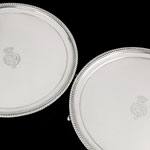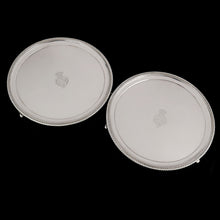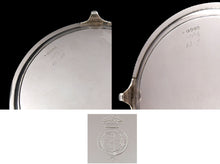One Leg - Field Marshal The Marquess of Anglesey’s Silver Salvers, 1818
SOLD
Tax included.
Adding product to your cart
Silver. A pair of George III circular salvers with gadrooned borders, each on four scroll feet, the field engraved with the arms of Paget family encircled by the Garter and surmounted by the coronet of marquess for Henry William Paget, 1st Marquess of Anglesey, K.G. Maker’s mark of the prestigious John Wakelin and Robert Garrard I. Engraved to the reverse with inventory markings - ‘No. 1’ / ‘12.13’ and ‘No. 4‘ / ‘13.5’. Hallmarked London 1795.
Provenance:
Field Marshal Henry William Paget, 1st Marquess of Anglesey (1768-1854)
thence by descent to
Henry Cyril Paget, 5th Marquess of Anglesey (1875-1905)
Read more
The armorial engraving on the present pair of salvers dates to circa 1818 after the Duke of Wellington’s cavalry commander at Waterloo, William Henry Paget, 2nd Earl of Uxbridge, was created 1st Marquess of Anglesey on 4 July 1815 and invested as a Knight of the Garter on 13 March 1818. Fittingly the present salvers were made by the prestigious silversmiths John Wakelin (fl1776-1802) and Robert Garrard I (1758-1818). Descendants of the latter became Garrard the Crown Jewellers in 1843. The salvers themselves were no doubt sold in 1905 at the 40-day estate sale following the death of the highly flamboyant ‘Toppy’, 5th Marquess of Anglesey whose wild extravagance led to his bankruptcy in 1904.
Henry William Paget, 1st Marquess of Anglesey (1768-1854) commanded the cavalry in the Peninsula army of Sir John Moore in 1808, forcibly demonstrating the superiority of the British light cavalry arm at the battles of Sahagún, where the 15th Hussars destroyed French 8th Dragoons and the 1st Provisional Chasseurs (commanded by a relative of the Empress Josephine) and at Benavente, where he defeated the elite Chasseurs à cheval of the French Imperial Guard. However he was unable to further serve in the Peninsula under Wellington due to his scandalous liaison with Wellington’s sister-in-law.
In 1815, having inherited the earldom of Uxbridge from his father, he was appointed cavalry commander in Belgium, under the still resentful eye of Wellington. At Waterloo he led the spectacular charge of the heavy cavalry against Comte d’Erlon’s column, and, at the end of the day, was hit in the right leg by a cannonball, leading to the famous exchange with Wellington.
"By God, sir, I've lost my leg!" — to which Wellington replied, "By God, sir, so you have!" According to his aide-de-camp Thomas Wildman, during the subsequent amputation Paget smiled and said, "I have had a pretty long run. I have been a beau these forty-seven years and it would not be fair to cut the young men out any longer."
Use left/right arrows to navigate the slideshow or swipe left/right if using a mobile device








